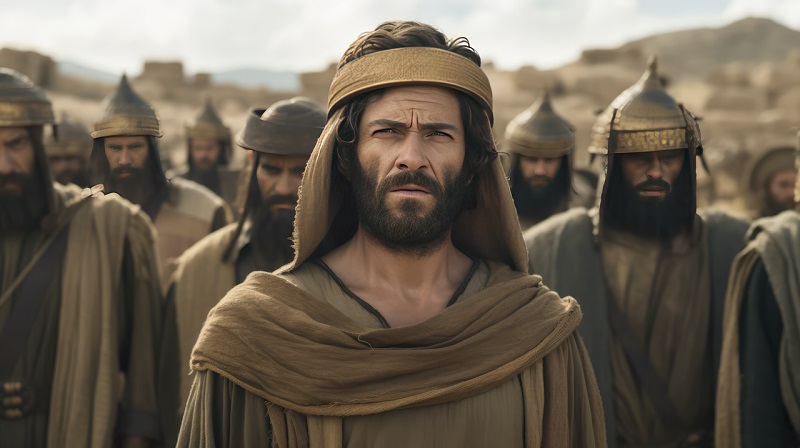In a world often divided by differences, the Bible presents profound examples of unity that invite us to rethink our interactions with others.
This article uncovers key biblical narratives and teachings that illustrate the strength found in coming together, emphasizing why unity is more crucial now than ever.
By engaging with these examples of unity in the Bible, you’ll learn how to cultivate more meaningful connections in your own life and community.
Prepare to be inspired and motivated as we dive deep into scripture’s timeless wisdom.
✅ The 5 Examples of Unity in the Bible

By examining these biblical instances, you’ll discover how unity can inspire and transform your own relationships.
1. The Early Church: Unity in Faith and Purpose
The early church stands as a powerful example of unity in the Bible, where believers embraced a shared vision that transcended individual desires.
Their collective dedication to the apostles’ teachings laid a foundational knowledge that encouraged deeper faith.
This unity wasn’t merely ideological; it manifested in tangible acts such as sharing resources and breaking bread together, embodying the principle of community living.
By engaging in such practices, they reinforced their connections, demonstrating that faith is best expressed in the context of relationships.
The support for the needy within their ranks exemplified a revolutionary approach to communal care.
This generosity was not confined to spiritual matters alone; it extended into every facet of life, fostering a culture where every individual felt valued and invested in.
This emphasis on mutual support not only strengthened their inner community but also amplified their witness to the world, turning heads and hearts towards the transformative nature of their faith.
In doing so, the early church illustrated that when individuals unite with a common purpose, the impact stretches far beyond themselves, influencing entire communities and inviting others to experience the joy of interconnected faith.
2. Nehemiah and the Israelites: Unity in Rebuilding Jerusalem
In Nehemiah 2-6, the Israelites provide a profound example of unity in the Bible, demonstrating how collective strength can transform adversity into achievement.
As they worked to restore the ruined walls of Jerusalem, each individual contributed according to their abilities — craftsmen, priests, and even the nobility came together despite their diverse backgrounds.
This illustrates that unity does not demand uniformity; rather, it thrives on the unique strengths each member brings.
Nehemiah’s role as a leader was crucial, as he not only reassured the people in the face of opposition but also encouraged shared ownership of the project, fostering a sense of communal responsibility.
The challenges they faced, including external threats and internal discouragement, only cemented their resolve.
With prayers woven into their labor, their focus on a common goal transcended their worries and turned obstacles into stepping stones.
This historical account highlights a core biblical truth: unified action rooted in shared faith can accomplish extraordinary things.
Just as the early church embodied unity in purpose, the Israelites’ efforts exemplified the power of collective will and divine guidance — reminding us that together, we can rebuild not just physical walls but also the spirit of community in our own lives.
3. David and His Men: Unity in Leadership and Loyalty
David and his men exemplify the profound power of loyalty and unity in leadership.
Their commitment to David is a vivid reminder of how trust can fortify relationships, especially in times of turmoil.
Each man, drawn from various backgrounds, found common ground in their respect for David’s vision and resilience.
This creates a tapestry of loyalty that not only aided in their survival but also allowed them to overcome formidable challenges together.
The synergy within their ranks resulted in remarkable achievements, showcasing how coordinated effort can turn the tide in seemingly insurmountable battles.
The stories of unity in the Bible, particularly in the context of David’s army, reveal that true solidarity transcends mere allegiance.
It fosters an environment where individuals feel empowered to contribute their strengths while relying on their comrades.
In navigating the complexities of leadership, David demonstrates that effective unity is a blend of mutual respect and shared goals.
This model stands as a timeless lesson for communities and organizations today, prompting us to reflect on how we can cultivate loyalty and teamwork in our everyday lives.
4. The Twelve Disciples: Unity in Mission
The Twelve Disciples exemplify an extraordinary model of collaboration, illustrating that diverse backgrounds can coalesce into a powerful force for a common mission.
While each disciple brought unique strengths — be it Peter’s boldness, Matthew’s analytical mind, or John’s deep compassion — they adhered to a unified vision in fulfilling Jesus’ directive.
Their ability to set aside individual differences for a shared purpose is one of the compelling stories of unity in the Bible, showcasing how God can work through varied personalities to achieve profound impacts.
In moments of adversity, the disciples relied on each other’s strengths, providing emotional and spiritual support that bolstered their resilience.
This unity didn’t only appear in their shared experiences during Jesus’ ministry but intensified after His resurrection, as they gathered not in fear but in fervent prayer, waiting for the Holy Spirit.
Their unwavering commitment to one another, despite the looming uncertainties, underscores the vital role of collaboration in spiritual endeavors.
This challenge of unity, woven through their experiences, reinforces the importance of community in navigating life’s trials and advancing a divine mission.
Through their collective efforts, we see that true success in ministry often lies not in individual accolades, but in shared visions that inspire and uplift all.
5. Paul’s Letters: Unity in the Body of Christ
In his letters, Paul vividly illustrates the beauty of unity within the varied members of the Body of Christ, urging believers to recognize and celebrate their differences.
For instance, in Romans 12:4-5, he compares the church to a body composed of various parts, each serving its distinct function.
This metaphor not only highlights the uniqueness of individual gifts — like teaching, service, and leadership — but also emphasizes how these roles interweave to enhance the church’s collective mission.
Just as a body cannot fully function if a hand or eye refuses to cooperate, Paul calls Christians to embrace their interdependence, understanding that exclusion undermines their collective strength.
Paul’s advocacy for unity resonates deeply with other biblical examples, such as the early church in Acts 2, where diverse believers came together in fellowship, sharing their resources and emphasizing the importance of community.
This spirit of inclusion fosters an environment where love thrives — each member, regardless of differences, contributes to a more profound sense of belonging.
Cooperating in mutual respect not only nurtures harmony but also enhances the church’s impact in the world, revealing a collective witness that reflects God’s love and purpose.
By embodying these principles, believers can experience the transformative power of unity, creating a vibrant tapestry of faith that honors God’s intentions for His community.
Examples of Unity in the Bible (Summary)
The Bible offers numerous examples of unity, demonstrating its power to strengthen faith, overcome adversity, and accomplish God’s purposes.
The early church thrived through shared devotion and fellowship, Nehemiah led a unified people to rebuild Jerusalem, and David’s men exemplified loyalty and solidarity.
The disciples achieved remarkable ministry through collective effort, and Paul’s teachings highlight the beauty of diverse gifts working together in the body of Christ.
These examples teach modern believers the value of cooperation, shared vision, and mutual support.
Unity fosters spiritual growth, resilience, and effective service, reflecting God’s heart for His people.
By embracing these lessons, individuals and communities can cultivate harmony, strengthen relationships, and fulfill God’s plan with faith, humility, and collaboration, ensuring that the church and families thrive in love and purpose.
FAQs About Unity in the Bible
1. What does unity mean in the Bible?
Unity in the Bible refers to harmony, cooperation, and togetherness among believers, reflecting shared faith, purpose, and devotion to God.
2. Who are examples of unity in the Bible?
Examples include the early church, Nehemiah and the Israelites, David and his men, the twelve disciples, and teachings from Paul about the body of Christ.
3. Why is unity important for believers?
Unity strengthens faith, fosters mutual support, enhances ministry effectiveness, and reflects God’s purpose for His people to work together in harmony.
4. How did Nehemiah demonstrate unity?
Nehemiah united the Israelites to rebuild Jerusalem’s walls, coordinating their efforts, encouraging collaboration, and overcoming opposition through shared purpose and prayer.
5. What lessons can modern believers learn from biblical unity?
Believers can learn to value collaboration, respect diverse gifts, maintain shared vision, and foster harmony in families, churches, and communities.
Other Blog Posts
- 5 Examples of Ungodliness in the Bible
- 5 Examples of Unforgiveness in the Bible
- 5 Examples of Unfaithfulness in the Bible

Grounded in faith and driven by purpose, I’m a Christian blogger and online research specialist with a passion for God’s Word, lifelong learning, and healthy living.
